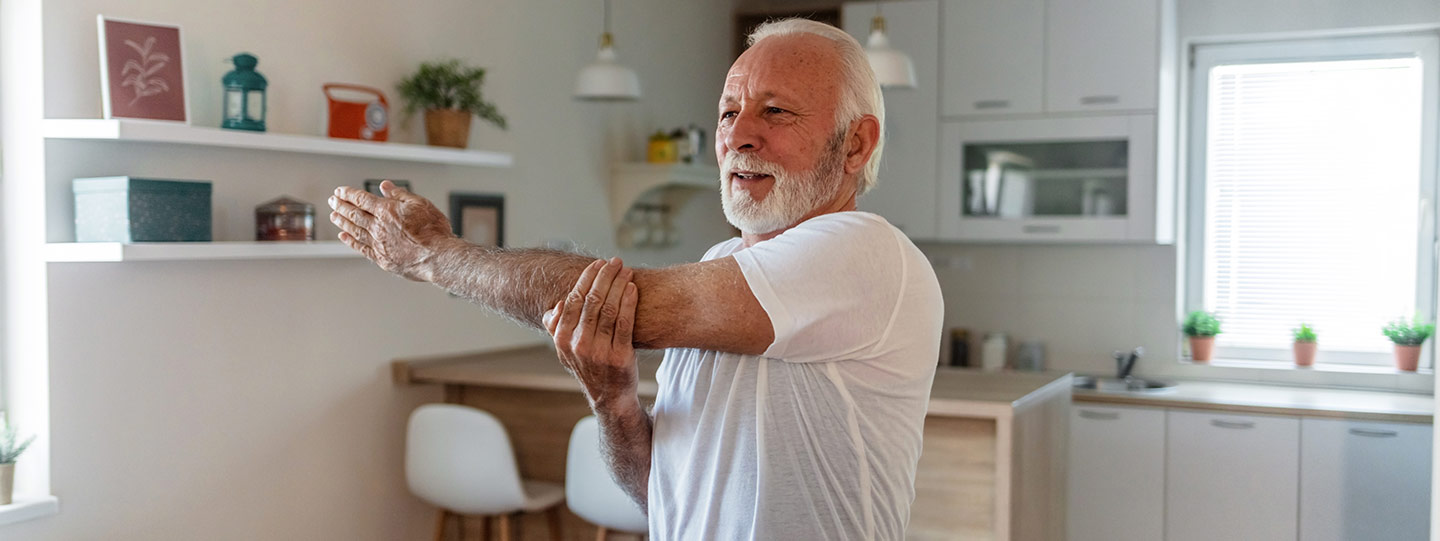How to maintain movement during a flare up
20 January 2025
Exercise may be the last thing on your mind when you’re in the middle of a flare up, but gentle, slow movement can help.
Allowing your body to rest is essential when arthritis symptoms feel particularly intense, yet gently moving and continuing some form of activity is just as important.
Have a look at the following tips to help ensure your body gets the movement it needs.
Try to keep moving
The general advice is to focus on slow and gentle movement during a flare up, rather than stopping altogether. While everyone’s situation is unique, some activity will usually be better than none, and this could be something as simple as completing some light stretching each morning.
Tim Allardyce adds that, for those really struggling with pain, even exercises completed while lying in bed can be useful. ‘For example, if you have a particularly sore knee or hip, just bending the hip or knee and using your hand to stretch the joint can provide improved mobility,’ he explains.
People with arthritis agree that it’s best to keep moving, with one advising to try ‘simple stretches for a few minutes, then rest and repeat until the body is able to do more’, and another recommending to ‘take things slower to start with until you get going’.
Prepare for exercise
Consider ways you can ease your body gently into exercising and support its recovery through the episode. This might mean applying a hot or cold compress before or after movement to soothe sore joints, timing your exercise around certain points of the day, or speaking to a physiotherapist about the best movements for you.
Depending on the activity you’re doing, make sure you’re wearing sensible clothing and footwear – and remember to warm up your muscles and joints before moving your body too much.
Lower the intensity
During a flare up, it’s important to be gentle to your body – so avoid intense or impactful movement that can jar joints or put pressure on specific areas.
‘Generally, high intensity, high impact or high volumes of exercise are most likely to aggravate symptoms,’ says Anderson. ‘Consider reducing the impact of your activities, by switching from 30-minute walks to 15-minute strolls.’
‘I recommend my patients choose exercises that help take the load off their joints during a flare up,’ adds Allardyce. ‘Gentle exercise helps mobility, and that helps reduce inflammation. Swimming is a great example of an exercise that won’t tend to aggravate pain, as is gentle walking on flat surfaces.’ Simply walking in water is great, too, in case you are worried about getting your hair wet in the pool.
Be mindful of your pain
The key is to listen to your body and be aware of anything that worsens pain. Never force a movement if it causes pain in a certain area and, instead, consider alternative ways to move, or modifications you can make to the exercise. ‘If a specific exercise significantly increases pain, it doesn’t necessarily mean you need to stop all together,’ adds Anderson. ‘Rather, consider how you could modify it. For example, resistance training is a vital component of structured movement for arthritis, but during a flare up, the amount of weight or number of repetitions may feel more uncomfortable.’
She advises first trying to reduce the load or weight for each movement, and then the number of sets. Remember, it’s important not to overdo any exercise during a flare up, as this can cause more pain.
Try our stretching series
The Versus Arthritis stretching series has been designed especially to help you perform gentle stretches from home. You’ll find videos with exercises for different parts of the body, as well as full-body morning and evening routines which can be done from the sofa or bed.
Find out more about full body stretching
Three easy moves to try today
Although the best exercises for you to try will depend on the type of arthritis you have and the location of the pain, Victoria Anderson says the three moves below can be useful in most situations.
Lumbar rotations
Helps to mobilise the lower back and hips
- Lay on your back with your knees bent and feet together.
- Now, rock your knees and hips gently to one side, towards the floor, and then bring them back to centre.
- Repeat on the other side.
Single leg knee hug
Helps stretch the hip and knee and joint space
- Lie on your back with your knees bent and both feet flat on the floor.
- Gently pull one knee up into your chest, hold the stretch, then release.
- Repeat on the other leg.
Hip abduction
Can be modified and performed when standing, seated or lying
- Place a resistance band around one ankle and to an anchor point on your opposite side.
- Move your leg outwards against the resistance band.
- Slowly lower the leg down to the floor and repeat a certain number of times (eg. five), before doing the same on the other leg.
Inspire magazine
If you would like to read more articles about managing your condition, take a look at our Inspire magazine. It is full of research updates, self-management tips, exercise advice and more, with stories from people with arthritis.
Read Inspire Magazine online for free